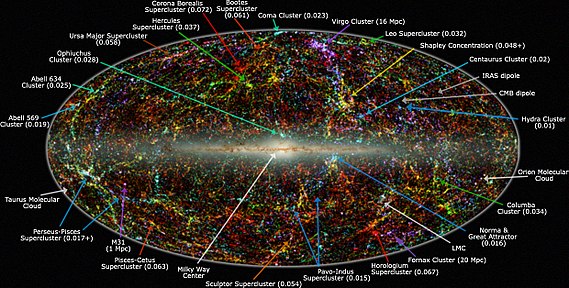

The Great Attractor is a region of gravitational attraction in intergalactic space and the apparent central gravitational point of the Laniakea Supercluster of galaxies that includes the Milky Way galaxy, as well as about 100,000 other galaxies.
The observed attraction suggests a localized concentration of mass having the order of 1016 solar masses.[1] However, it is obscured by the Milky Way's galactic plane, lying behind the Zone of Avoidance (ZOA), so that in visible light wavelengths, the Great Attractor is difficult to observe directly.[2]
The attraction is observable by its effect on the motion of galaxies and their associated clusters over a region of hundreds of millions of light-years across the universe. These galaxies are observable above and below the Zone of Avoidance; all are redshifted in accordance with the Hubble flow, indicating that they are receding relative to the Milky Way and to each other, but the variations in their redshifts are large enough and regular enough to reveal that they are slightly drawn towards the attraction. The variations in their redshifts are known as peculiar velocities, and cover a range from about +700 km/s to −700 km/s, depending on the angular deviation from the direction to the Great Attractor. The Great Attractor itself is moving towards the Shapley Supercluster.[2]
- ^ Cite error: The named reference
BehindMilkyWaywas invoked but never defined (see the help page). - ^ a b "What is the Great Attractor?". Universe Today. 14 July 2014. Retrieved 24 June 2018.